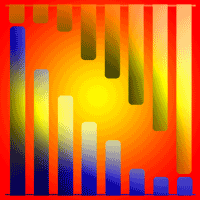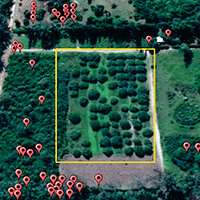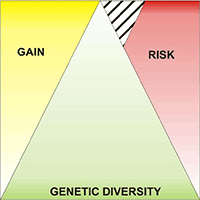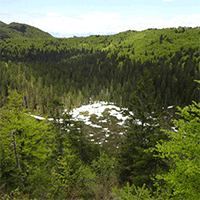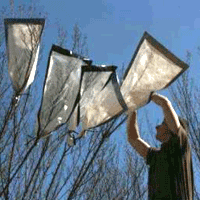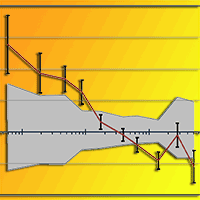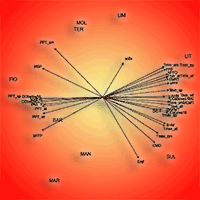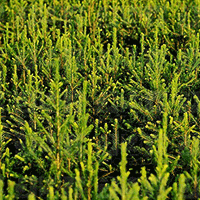The use of open-pollinated seeds from seed orchards is a common strategy for the deployment of genetically improved eucalypts, including Eucalyptus globulus, an important pulpwood tree in many temperate climate areas. However, seed quality can be affected by the rate of selfing and to a lesser extent by contamination from pollen outside the orchard. Inbreeding between related parents and especially from self-crosses is known to cause diminished growth and developmental abnormalities in the resulting progeny. This study looks at the magnitude and variation in selfing and the impact in inbreeding depression across several E. globulus families collected over the years in a seed orchard. The effects on growth and development of outcrossed and selfed progeny were studied across five progeny trials, after pedigree reconstruction of the open pollinated progeny based on SSR genotyping. An additive genetic mixed linear model was fitted to the data to evaluate the impact of inbreeding on height growth. The results showed a significant inbreeding depression, with a height growth reduction of 15% in selfed progeny, when compared with crosses from unrelated parents. These inbreeding depression values varied among families, ranging between 7% and 24%, evidencing the importance of genetic background. Contamination rates were on average 10% suggesting long distance pollen dispersal was present. A small number of abnormal phenotypes (less than 10%) was observed in the field. This was associated with specific, unrelated, crosses and not to high inbreeding rates such as found among selfed progeny. The relevance of these results for orchard management and parent selection is discussed.
Keywords
, , , , ,
Citation
Faia J, Costa J, Araújo J, Borralho N, Marques C, Trindade H (2022). Impact of inbreeding on growth and development of young open-pollinated progeny of Eucalyptus globulus. iForest 15: 356-362. - doi: 10.3832/ifor4012-015
Academic Editor
Alberto Santini
Paper history
Received: Nov 05, 2021
Accepted: Jul 06, 2022
First online: Sep 20, 2022
Publication Date: Oct 31, 2022
Publication Time: 2.53 months
© SISEF - The Italian Society of Silviculture and Forest Ecology 2022
Open Access
This article is distributed under the terms of the Creative Commons Attribution-Non Commercial 4.0 International (https://creativecommons.org/licenses/by-nc/4.0/), which permits unrestricted use, distribution, and reproduction in any medium, provided you give appropriate credit to the original author(s) and the source, provide a link to the Creative Commons license, and indicate if changes were made.

Breakdown by View Type
(Waiting for server response...)
Article Usage
Total Article Views: 27096
(from publication date up to now)
Breakdown by View Type
HTML Page Views: 23349
Abstract Page Views: 1913
PDF Downloads: 1410
Citation/Reference Downloads: 4
XML Downloads: 420
Web Metrics
Days since publication: 1205
Overall contacts: 27096
Avg. contacts per week: 157.40
Article Citations
Article citations are based on data periodically collected from the Clarivate Web of Science web site
(last update: Mar 2025)
(No citations were found up to date. Please come back later)
Publication Metrics
by Dimensions ©
Articles citing this article
List of the papers citing this article based on CrossRef Cited-by.
(1)
Alves A, Pereira J, Silva J (2007)A introdução e a expansão do eucalipto em Portugal [Introduction and expansion of eucalypt in Portugal]. In: “O Eucaliptal em Portugal: Impactes Ambientais e Investigação Científica” (Alves AM, Pereira JS, Silva JMN eds), ISA Press, Lisboa, Portugal, pp. 13-24. [in Portuguese]
Gscholar
(2)
Araújo JA, Borralho NMG, Dehon G (2012)The importance and type of non-additive genetic effects for growth in
Eucalyptus globulus. Tree Genetics and Genomes 8: 327-337.
CrossRef |
Gscholar
(3)
Araújo JA, Lemos L, Ramos A, Ferreira JG, Borralho NMG (1997)The RAIZ
Eucalyptus globulus breeding program: a BLUP rolling front strategy with a mixed clonal and seedling deployment scheme. In: Proceedings of the IUFRO conference on “Silviculture and Improvement of Eucalypts”. Salvador (Bahia, Brazil) 24-29 Aug 1997. EMBRAPA, Brazil, pp. 371-378.
Gscholar
(4)
Barbour RC, Potts BM, Vaillancourt RE (2005)Pollen dispersal from exotic eucalypt plantations. Conservation Genetics 6: 253-257.
CrossRef |
Gscholar
(5)
Borralho NMG, Kanowski PJ, Cotterill PP (1992)Genetic control of growth of
Eucalyptus globulus in Portugal. I: Genetic and Phenotypic Parameters. Silvae Genetica 41: 39-45.
Gscholar
(6)
Borralho NMG, Almeida MH, Potts BM (2007)O melhoramento do eucalipto em Portugal [Eucalypt improvement in Portugal]. In: “O Eucaliptal em Portugal: Impactes Ambientais e Investigação Científica” (Alves AM, Pereira JS, Silva JMN eds). ISA Press, Lisboa, Portugal, pp. 61-110. [in Portuguese]
Gscholar
(7)
Burczyk J, DiFazio SP, Adams WT (2004)Gene flow in forest trees: how far do genes really travel? Forest Genetics 11 (3-4): 179-192.
Gscholar
(8)
CELPA (2019)Boletim Estatístico da CELPA [CELPA Statistical Bulletin]. CELPA - Associação da Indústria Papeleira, Lisboa, Portugal, pp. 112. [in Portuguese]
Gscholar
(9)
Chaix G, Gerber S, Razafimaharo V, Vigneron P, Verhaegen D, Hamon S (2003)Gene flow estimation with microsatellites in a Malagasy seed orchard of
Eucalyptus grandis. Theoretical and Applied Genetics 107: 705-712.
CrossRef |
Gscholar
(10)
Chaix G, Vigneron P, Razafimaharo V, Hamon S (2010)Improved management of Malagasy
Eucalyptus grandis seed orchards using microsatellite and paternity assignment. Journal of Tropical Forest Science 22: 271-280.
Online |
Gscholar
(11)
Charlesworth D, Willis JH (2009)The genetics of inbreeding depression. Nature Reviews Genetics 10: 783-796.
CrossRef |
Gscholar
(12)
Cockerham CC (1967)Group inbreeding and coancestry. Genetics 56: 89-104.
CrossRef |
Gscholar
(13)
Costa e Silva J, Borralho NMG, Potts BM (2004)Additive and non-additive genetic parameters from clonally replicated and seedling progenies of
Eucalyptus globulus. Theoretical and Applied Genetics 108 (6): 1113-1119.
CrossRef |
Gscholar
(14)
Costa e Silva J, Hardner C, Potts BM (2010)Genetic variation and parental performance under inbreeding for growth in
Eucalyptus globulus. Annals of Forest Science 67: 606.
CrossRef |
Gscholar
(15)
Costa e Silva J, Hardner C, Tilyard P, Potts BM (2011)The effects of age and environment on the expression of inbreeding depression in
Eucalyptus globulus. Heredity 107: 50-60.
CrossRef |
Gscholar
(16)
Costa J, Vaillancourt RE, Steane DA, Jones RC, Marques C (2017)Microsatellite analysis of population structure in
Eucalyptus globulus. Genome 60: 770-777.
CrossRef |
Gscholar
(17)
Field DL, Ayre DJ, Whelan RJ, Young AG (2011)The importance of pre-mating barriers and the local demographic context for contemporary mating patterns in hybrid zones of
Eucalyptus aggregata and
Eucalyptus rubida. Molecular Ecology 20: 2367-2379.
CrossRef |
Gscholar
(18)
Freeman JS, Marques CM, Carocha V, Borralho N, Potts BM, Vaillancourt RE (2007)Origins and diversity of the Portuguese landrace of
Eucalyptus globulus. Annals of Forest Science 64 (6): 639-647.
CrossRef |
Gscholar
(19)
Fuchs MCP, Tambarussi EV, Lourenção JC, Nogueira LM, Bortoloto TM, González ER, Oda S, Marino CL (2015)Molecular marker associated with a deleterious recessive anomaly in
Eucalyptus grandis seedlings. Annals of Forest Science 72: 1043-1052.
CrossRef |
Gscholar
(20)
Gilmour AR, Gogel BJ, Cullis BR, Welham SJ, Thompson R (2021)ASReml user guide release 4.2: functional specification. VSN International Ltd, Hemel Hempstead, HP2 4TP, UK.
Online |
Gscholar
(21)
Gonzaga JMS, Manoel RO, Sousa ACB, Souza AP, Moraes MLT, Freitas MLM, Sebbenn AM (2016)Pollen contamination and nonrandom mating in a
Eucalyptus camaldulensis Dehnh seedling seed orchard. Silvae Genetica 65: 1-11.
CrossRef |
Gscholar
(22)
Grattapaglia D, Sederoff R (1994)Genetic linkage maps of
Eucalyptus grandis and
Eucalyptus urophylla using a pseudo-testcross: mapping strategy and RAPD markers. Genetics 137: 1121-1137.
CrossRef |
Gscholar
(23)
Griffin AR (2014)Clones or improved seedlings of Eucalyptus? Not a simple choice. International Forestry Review 16: 216-224.
CrossRef |
Gscholar
(24)
Hardner CM, Potts BM (1995)Inbreeding depression and changes in variation after selfing in
Eucalyptus globulus ssp.
globulus. Silvae Genetica 44: 46-54.
Gscholar
(25)
Hingston AB, Potts BM, McQuillan PB (2004a)The swift parrot
Lathamus discolor (Psittacidae), social bees (Apidae), and native insects as pollinators of
Eucalyptus globulus ssp.
globulus (Myrtaceae). Australian Journal of Botany 52: 371-379.
CrossRef |
Gscholar
(26)
Hingston AB, Potts BM, McQuillan PB (2004b)Pollination services provided by various size classes of flower visitors to
Eucalyptus globulus ssp.
globulus (Myrtaceae). Australian Journal of Botany 52: 353-369.
CrossRef |
Gscholar
(27)
Jones ME, Shepherd M, Henry R, Delves A (2008)Pollen flow in
Eucalyptus grandis determined by paternity analysis using microsatellite markers. Tree Genetics and Genomes 4: 37-47.
CrossRef |
Gscholar
(28)
Jordan GJ, Potts BM, Kirkpatrick JB, Gardiner C (1993)Variation in the
Eucalyptus globulus complex revisited. Australian Journal of Botany 41: 763-785.
CrossRef |
Gscholar
(29)
Kalinowski ST, Taper ML, Marshall TC (2007)Revising how the computer program CERVUS accommodates genotyping error increases success in paternity assignment. Molecular Ecology 16: 1099-1106.
CrossRef |
Gscholar
(30)
Kenward MG, Roger JH (1997)Small sample inference for fixed effects from restricted maximum likelihood. Biometrics 53: 983-997.
CrossRef |
Gscholar
(31)
Klekowski EJ (1988)Genetic load and its causes in long-lived plants. Trees 2: 195-203.
CrossRef |
Gscholar
(32)
Lindgren D, Gea LD, Jefferson PA (1997)Status number for measuring genetic diversity. International Journal of Forest Genetics 2: 69-76.
Gscholar
(33)
Lindgren D, Mullin TJ (1998)Relatedness and status number in seed orchard crops. Canadian Journal of Forest Research 28: 276-283.
CrossRef |
Gscholar
(34)
Lynch M, Walsh B (1998)Genetics and analysis of quantitative traits. Sinauer Associates Inc, Sunderland, MA, USA, pp. 807.
Online |
Gscholar
(35)
Marshall TC, Slate J, Kruuk LEB, Pemberton JM (1998)Statistical confidence for likelihood-based paternity inference in natural populations. Molecular Ecology 7: 639-655.
CrossRef |
Gscholar
(36)
McGowen MH, Vaillancourt RE, Pilbeam DJ, Potts BM (2010)Sources of variation in self-incompatibility in the Australian forest tree,
Eucalyptus globulus. Annals of Botany 105: 737-745.
CrossRef |
Gscholar
(37)
Moncur MW, Mitchell A, Fripp Y, Kleinschmit GJ (1995)The role of honey bees (
Apis mellifera) in eucalypt and acacia seed production areas. The Commonwealth Forestry Review 74: 350-354.
Online |
Gscholar
(38)
Moran GF, Bell JC (1983)Eucalyptus. In: “Isozymes in Plant Genetics and Breeding, Part B” (Tanskley SD, Orton TJ eds). Elsevier, Amsterdam, Netherlands, pp. 423-441.
Gscholar
(39)
Nickolas H, Harrison PA, Tilyard P, Vaillancourt RE, Potts BM (2019)Inbreeding depression and differential maladaptation shape the fitness trajectory of two co-occurring
Eucalyptus species. Annals of Forest Science 76: 10.
CrossRef |
Gscholar
(40)
Patterson B, Vaillancourt RE, Pilbeam DJ, Potts BM (2004)Factors affecting variation in outcrossing rate in
Eucalyptus globulus. Australian Journal of Botany 52: 773-780.
CrossRef |
Gscholar
(41)
Potts BM, Wiltshire RJE (1997)Eucalypt genetics and genecology. In: “Eucalypt Ecology: Individuals to Ecosystems” (Williams J, Woinarski J eds). Cambridge University Press, Cambridge, pp. 56-91.
Online |
Gscholar
(42)
Pound LM, Wallwork MAB, Potts BM, Sedgley M (2002)Self-incompatibility in
Eucalyptus globulus ssp.
globulus (Myrtaceae). Australian Journal of Botany 50: 365-372.
CrossRef |
Gscholar
(43)
Pupin S, Sebbenn AM, Cambuim J, Da Silva AM, Zaruma DUG, Silva PHM, Rosse LN, Souza ICG, Marino CL, Moraes MLT (2019)Effects of pollen contamination and non-random mating on inbreeding and outbreeding depression in a seedling seed orchard of
Eucalyptus urophylla. Forest Ecology Management 437: 272-281.
CrossRef |
Gscholar
(44)
Rao H, Patterson B, Potts BM, Vaillancourt RE (2008)A microsatellite study of outcrossing rates and contamination in a
Eucalyptus globulus breeding arboretum. Journal of Forestry Research 19: 136-140.
CrossRef |
Gscholar
(45)
Ribeiro MM, Sanchez L, Ribeiro C, Cunha F, Araújo JA, Borralho N, Marques CM (2011)A case study of
Eucalyptus globulus fingerprinting for breeding. Annals of Forest Science 68: 701-714.
CrossRef |
Gscholar
(46)
Self SG, Liang KY (1987)Asymptotic properties of maximum likelihood estimators and likelihood ratio tests under nonstandard conditions. Journal of the American Statistical Association 82: 605-610.
CrossRef |
Gscholar
(47)
Tomé M, Tomé JA, Araújo MC, Pereira JS (1994)Intraspecific competition in irrigated and fertilized eucalypt plantations. Forest Ecology and Management 69: 211-218.
CrossRef |
Gscholar
(48)
Weiner J, Damgaard C (2006)Size-asymmetric competition and size-asymmetric growth in a spatially explicit zone-of-influence model of plant competition. Ecological Research 21: 707-712.
CrossRef |
Gscholar
(49)
Wellmann R (2019)Optimum contribution selection for animal breeding and conservation: the R package optiSel. BMC Bioinformatics 20: 25.
CrossRef |
Gscholar
(50)
Zhang Z, Papaik MJ, Wang X, Hao Z, Ye J, Lin F, Yuan Z (2017)The effect of tree size, neighborhood competition and environment on tree growth in an old growth temperate forest. Journal of Plant Ecology 10: 970-980.
CrossRef |
Gscholar
